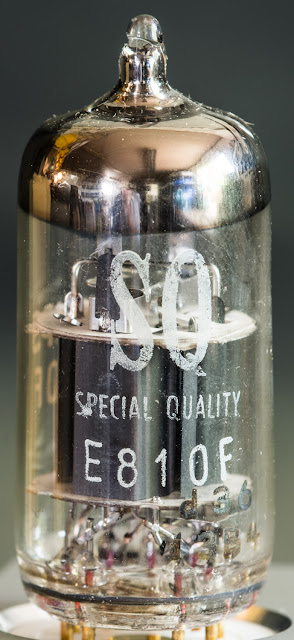This months tube is a high transconductance pentode designed for wide band amplifier applications, the E810F.
As the intended application implies, this tube was mainly used for very high frequencies in the hundreds of MHz, but can be used for audio frequencies as well.
 The E810F comes in a small 9 pin noval bottle. It shares the same pinout with the D3a and is also somewhat comparable to it. It has the same heater voltage of 6.3V and needs a similar current of 320-360mA. In triode connection it has a bit lower amplification compared to the D3a but still a high value of 60. It was designed as 'special quality' tube with a high life time of 10.000 hours and a cathode which is interface free. This means it does not develop cathode poisoning when operated for an extended period with heater voltage applied but no plate voltage. It is also very resistant against shocks and vibration. The ruggedness of the tube is also indicated by the name E810F with the digits between the letters. The E is for 6.3V parallel heating and the F identifies a pentode. The placement of the digits indicates if it is an industrial/military or a commercial type. Many applications in audio are possible and I prefer such tubes for small signal amplification as in phono stages.
The E810F comes in a small 9 pin noval bottle. It shares the same pinout with the D3a and is also somewhat comparable to it. It has the same heater voltage of 6.3V and needs a similar current of 320-360mA. In triode connection it has a bit lower amplification compared to the D3a but still a high value of 60. It was designed as 'special quality' tube with a high life time of 10.000 hours and a cathode which is interface free. This means it does not develop cathode poisoning when operated for an extended period with heater voltage applied but no plate voltage. It is also very resistant against shocks and vibration. The ruggedness of the tube is also indicated by the name E810F with the digits between the letters. The E is for 6.3V parallel heating and the F identifies a pentode. The placement of the digits indicates if it is an industrial/military or a commercial type. Many applications in audio are possible and I prefer such tubes for small signal amplification as in phono stages. I have not used the E810F much myself since I have plenty stock of D3a but only few E810F. With it's high transconductance which results in high usable amplification factor at low plate resistance in triode connection it is well suited for transformer coupling. Of course other modes of operation and pentode connection are perfectly feasible as well. As with all high transconductance tubes special care needs to be taken to avoid parasitic oscillations. This can be ensured by careful layout and suitable grid stoppers. As far as I am aware it was produced by Valvo (which was acquired by Philips) Telefunken and Siemens. Probably also by Mullard. I only have Valvo and Philips branded tubes in my collection. As always lets start with a look at the triode connected plate curves:
I have not used the E810F much myself since I have plenty stock of D3a but only few E810F. With it's high transconductance which results in high usable amplification factor at low plate resistance in triode connection it is well suited for transformer coupling. Of course other modes of operation and pentode connection are perfectly feasible as well. As with all high transconductance tubes special care needs to be taken to avoid parasitic oscillations. This can be ensured by careful layout and suitable grid stoppers. As far as I am aware it was produced by Valvo (which was acquired by Philips) Telefunken and Siemens. Probably also by Mullard. I only have Valvo and Philips branded tubes in my collection. As always lets start with a look at the triode connected plate curves:Here we have a Valvo E810F:
Some close ups:
The plate is composed of several pieces.
Gold plated pins:
The tip:
A Philips branded E810F:
US military designation number added to the box of these:
Philips E810F marking on one side:
And the SQ special quality on the other:
Construction is the same as the Valvo above.
Some close ups:
Also with gold pins:
But not all of them had the gold plating, I also have some Philips E810F with regular pins:
Let's have a closer look inside:
Once the glass is broken, the getter starts to react with the air:
And is completely gone after a few minutes:
The tube without the glass obstructing the view:
Close up, showing the heater spiral:
Removing the heater:
The bottom:
Getter ring:
Here the several pieces of the plate can be seen.
Only the narrow stripe close to the cathode is actually serving as plate surface:
Cathode:
Here part of the plate is bent away to give a look at the beam forming plate (g3) and the other grids (hardly visible de to their thinness):
One piece of the plate:
Here we get a better view of the grids
Close up:
Here we already get an impression of the extremely fine grids. The more coarsely wound screen grid with black coating and the actual control grid beneath.
Some extreme close ups:
A human hair in comparison:
What a marvellous piece of vacuum tube engineering!
Best regards
Thomas
Addendum:
A reader of my blog kindly provided this photo of Telefunken branded E810Fs:
Thanks to 'Wagtbtoobz' for the photo and this additional information:
All Telefunken and Mullard branded E810F were manufactured by Philips.



























































